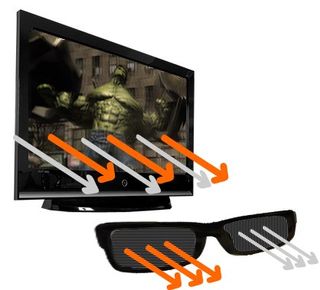Or, How the movies do it

Above: from3d glasses.net
You can credit the revival of 3D in the last decade to these beauties here. The technology behind polarization lenses seems complex if you don’t know the terminology, but in essence, here’s what’s going on inside the glasses:

Above: Lotta little lines
The image above represents linear polarization: a bunch of lines make up a filter. Like with the Virtual Boy, polarization 3D takes your original left and right-eye images and projects each image separately. However, with the linear polarization system, two synced-up projectors aim the images for each eye. The light from each specially-designed projector is made up of either tiny vertical or horizontal lines – your polarized glasses have the crazy-scientific equivalent of either vertical or horizontal cracks, which allow only the light from the correctly aligned image to pass through.
Here’s a handy diagram we made to help!

Above: Polarization is great for watching Attack Of The Jolly Green Giant on a screen the size of an index card
By utilizing a system of filters based on physical space rather than the old anaglyph color system, polarization can produce a convincing 3D effect without a loss of color. There are only two problems with the linear polarization method: one, you can’t really tilt your head to the left or right without screwing up the alignment of the light, and two, you can’t produce polarized 3D without two expensive projectors, each with the ability to project polarized light. For moviegoers, these aren’t really issues - no one minds staring at a screen for two hours, and the theater provides all the necessary equipment. However, for all-night gaming sessions with your regular ol’ HDTV, you’ll need to bust out some new, bleeding-edge technology.
RealD is the nickname given to a system of circular polarization, which takes the same basic concept behind linear polarization but - you guessed it - uses a circular light frequency instead. This tech was first used in that Chicken Little movie that came out in 2005, and it’s been used in nearly all 3D movies since. RealD is rapidly becoming the industry standard, as it requires only one special projector or display, and allows for much more freedom of head movement.
How it looks on Han Tao:
How it looks on Han Tao:
How it looks on Han Tao:
